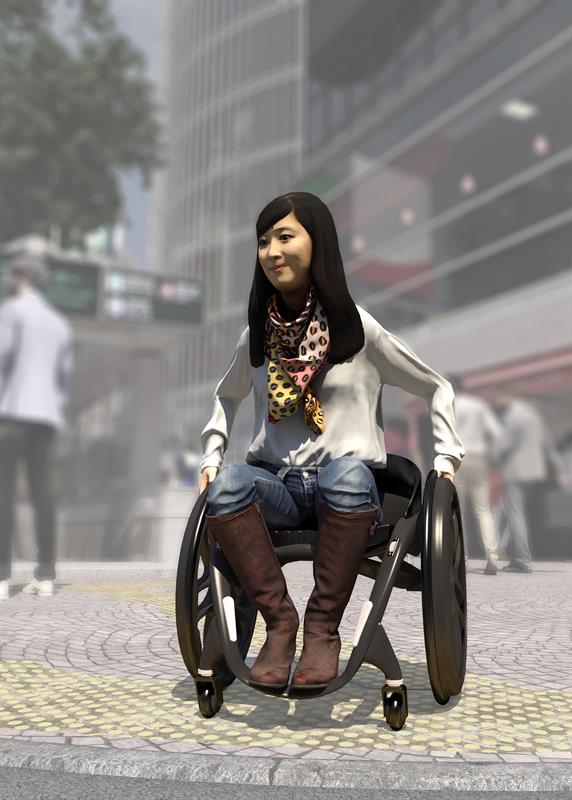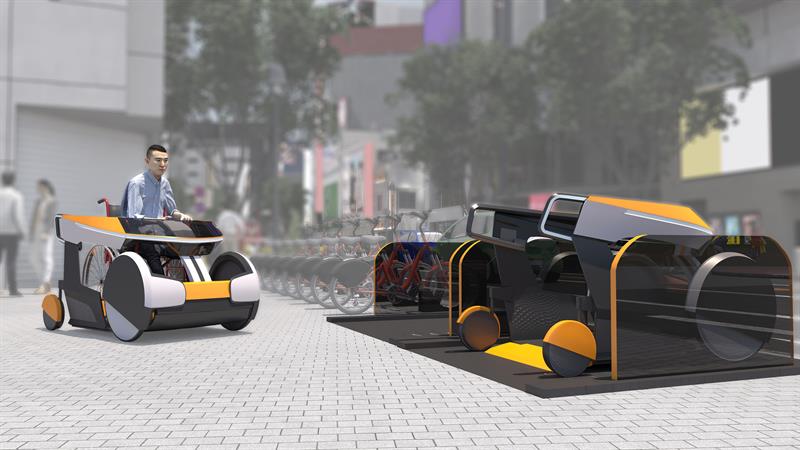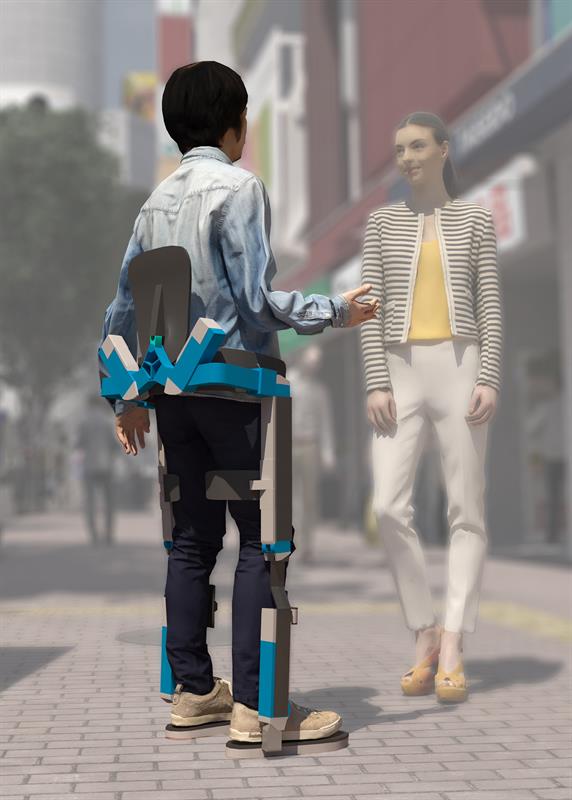This is very much a model that those pursuing similar advances in mobility are hoping to emulate. Increasingly, the issue of mobility is coming to the fore, with greater financial and intellectual investment in it.
One recent high-profile example of this was the unveiling at the Consumer Electronics Show in Las Vegas of the five finalists in the three-year Mobility Unlimited Challenge.
The Toyota Mobility Foundation launched this $4 million global challenge in 2017 in partnership with Nesta’s Challenge Prize Centre, with the aim of improving the lives of millions of people with lower-limb paralysis.
Around the world, millions of people are living with lower-limb paralysis (the most common causes being strokes, spinal cord injury and multiple sclerosis). While there are no statistics on paralysis worldwide, the World Health Organization estimates there are 250,000-500,000 new cases of spinal cord injury globally every year.
Charlotte Macken of Nesta’s Challenge Prize Centre said: “Current personal mobility devices are often unable to fully meet the needs of users due to limitations affecting functionality and usability. Historically, the pace of innovation is slow, due to small and fragmented markets and difficulties in getting new technology funded by health-care systems and insurers. This can make the field unattractive to the very people who could help change the world. We hope that challenges like this can inspire innovation and are excited to see how the five finalists use this opportunity to develop their ideas further.”
The Challenge invited engineers, innovators, and designers from across the world to submit designs for game-changing technologies, incorporating intelligent systems, to improve the mobility and independence of people with lower-limb paralysis. Central to the Challenge is the importance of collaboration with end-users to develop devices that will integrate seamlessly into users’ lives and environments, while being comfortable and easy to use, enabling greater independence and increased participation in daily life.
Devices range from a hybrid exoskeleton on wheels, to a powered wheelchair share scheme. Each finalist will receive a $500,000 grant to develop their idea further and the final winner will be awarded $1 million in 2020 in Tokyo.
The UK finalist is the Phoenix AI Ultralight Wheelchair, which is designed to be a manual wheelchair made from carbon-fibre that will use smart sensors to configure itself to what the user does. It will allow the wheelchair to remain in sync with how the user moves, with sensors detecting if the user is leaning forward or back and algorithms calculating the wheelchair’s response.
Intelligent centre
According to Phoenix Instant, the wheelchair will include a number of smart functions yet to have been incorporated into wheelchair design, including an intelligent centre of gravity that will allow the device to continually adjust its centre of gravity to fit what the user does.
The team says it will make for a chair that is easier to push and turn by eliminating drag and uncomfortable, painful vibration whilst also making the chair safe from falling backwards. A lightweight power assist feature will also help users navigate slopes easier and an automatic braking system will remove the need for users to grip the wheels to slow down.
No stranger to carbon-fibre wheelchairs, accomplished product designer Andrew Slorance, director of Phoenix Instinct, has had his designed exhibited in the London Design Museum and created products sold worldwide.
As with the example of the prosthetic limbs, Slorance feels that the central technology of the wheelchair is long out of date and overdue an update.

While conceding that the wheelchair has proved itself as the most viable mobility device for decades has done well in that capacity, he now believes it is “tired” and “in need of a serious makeover”. The intention of this design, therefore, was to show how he believes that the wheelchair can be evolved while maintaining the core, proven fundamental capabilities that are behind its success as a mobility device.
Slorance wanted to be part of this Challenge because he broke his back aged 14 (he is 49 now). By the time he was 16, he’d decided that I would one day design a wheelchair that would change perceptions by using cutting-edge materials and styling.
He knew the next step beyond advanced materials has to be to make wheelchairs smart. But that costs a huge amount of money in development. So, when he saw this Challenge, he saw the opportunity to raise the money necessary to develop this technology.
This he felt was crucial since, without this impetus, he believed no-one else was going to do it. No company is going to decide to spend half a million dollars on research and development to advance the manual wheelchair as long as their competitor also doesn’t do it the status quo can continue with wheelchairs remaining much as they were thirty-five years ago.
This Challenge changes that. But now, of course, is where the work really begins. The competitors have got eighteen months to turn the wheelchair which has been in the technological dark for so long into a futuristic device that intelligently makes wheelchair life easier.
Evowalk
But the competition is stiff. Other entries include the Evowalk from Evolution Devices in the United States. This is a non-intrusive sleeve which goes around the user’s leg and has sensors that track walking motion and stimulate the right muscles at the right time to improve mobility.This particular type of muscle stimulation, it is believed, will also rehabilitate muscles over time.
According to the team, the device offers personalised, timed muscle stimulation that allows its users to contract their muscles as they walk. This contraction will not only assist users on a day-to-day basis,according to Evolution Devices, but also rehabilitate the muscles and neural pathways over time.
Pierluigi Mantovani from Evolution Devices said: “Mobility Unlimited Challenge is a fantastic opportunity for people to build devices that are normally hard to fund but could make a huge difference. This support will help us finish our research and develop the device further, so we can get it to the people who really need it. People like my dad.
“My dad has multiple sclerosis and developed foot drop. He was recommended a device that was far too expensive so myself and some friends built this prototype that helped. After that, we wanted to make something affordable for others. Our main goal has always been to help people regain the ability to walk freely again.”
Moby, from Italdesign in Italy is the first mobility service created for wheelchair users, operating like a cycle share scheme in urban hubs. Offering a series of wheel-on electric devices, it will make travelling around cities much simpler and easier for people with lightweight manual wheelchairs.

The service is accessible via an app-based share scheme. This allows users of the platform to interact with other wheelchair users, the device itself, as well as other means of transport.
Serena De Mori from Italdesign said: “Moby is a concept we developed over time, working with users of wheelchairs. They said they wanted a way to make travelling easier and so we developed this platform.
“We entered this Challenge because we wanted to have a different kind of mobility solution which is accessible to all. We are very happy to have been selected for the Challenge and hope to develop the concept further and to build the first prototypes to test on the street as soon as possible.”
Qolo (Quality of Life with Locomotion) comes from Team Qolo, University of Tsukuba, Japan. This is a mobile exoskeleton on wheels that helps users to sit or stand with ease, effectively removing the ‘chair’ from ‘wheelchair’. Mobility is controlled using the upper body, allowing hands-free operation. The device enables users to travel around in a standing position, changing both physiological and social aspects of everyday living.
The QOLO Standing Device consists of a lightweight, mobile exoskeleton on wheels which uses passive actuators to allow users to sit or stand, effectively removing the ‘chair’ from ‘wheelchair’.
 Users operate the device using their upper body, enabling people to keep their hands free, whilst the device allows the user to travel in a standing position. The ability to regain upright mobility changes both the physiological and social aspects of everyday living for those with lower limb paralysis says the team.
Users operate the device using their upper body, enabling people to keep their hands free, whilst the device allows the user to travel in a standing position. The ability to regain upright mobility changes both the physiological and social aspects of everyday living for those with lower limb paralysis says the team.
Quix, IHMC & Myolin (United States): a highly mobile, powered exoskeleton offering fast, stable and agile upright mobility, Quix uses modular actuation, perception technology from autonomous vehicles and control algorithms for balancing autonomous humanoid robots to deliver the mobility, safety and independence that current exoskeletons cannot provide.
The team says the exoskeleton is able to provide the mobility, safety and independence current exoskeletons on the market are unable to via modular actuation, perception technology from autonomous vehicles and control algorithms for balancing autonomous humanoid robots.
Developing Tech
Peter Neuhaus from IHMC & Myolin said: “In the business world, developing technologies for people with lower-limb paralysis has been extraordinarily hard. We’ve constantly struggled against people saying the market is too small and because of that people aren’t putting in the effort, research or investment this field deserves, meaning there hasn’t been enough advancement.
A total of 80 entries were received from 28 countries and the finalists were chosen by a panel of expert judges including, from the UK, Sophie Morgan, television presenter and disability advocate, and Ruth Peachment, Occupational Therapy Clinical Specialist at the National Spinal Injuries Centre.
Dr Eric Krotkov, chief science officer at the Toyota Research Institute and one of the Challenge judges, said: “There are so many technological opportunities to explore approaches to alleviate challenges stemming from lower-limb paralysis. A competition like the Mobility Unlimited Challenge gets innovators to focus on the same problem to identify something of great common interest that serves society. I am excited by these finalists who have a breadth of technical approaches such as wheelchairs, orthotics, braces and exoskeletons. I look forward to seeing how they will take these devices out of their conceptual stage to help our end users.”
Ryan Klem, director of programs for the Toyota Mobility Foundation commented: “These five finalists have shown real innovation driven by human-centred design. We think that the technology incorporated in these devices could change the lives of a huge number of people around the world, not just for those with lower-limb paralysis, but also those with a wider range of mobility needs. It will be fascinating to follow the teams’ journeys and see how the $500,000 grant will help them develop their ideas to bring them to market and into the hands of users.”





